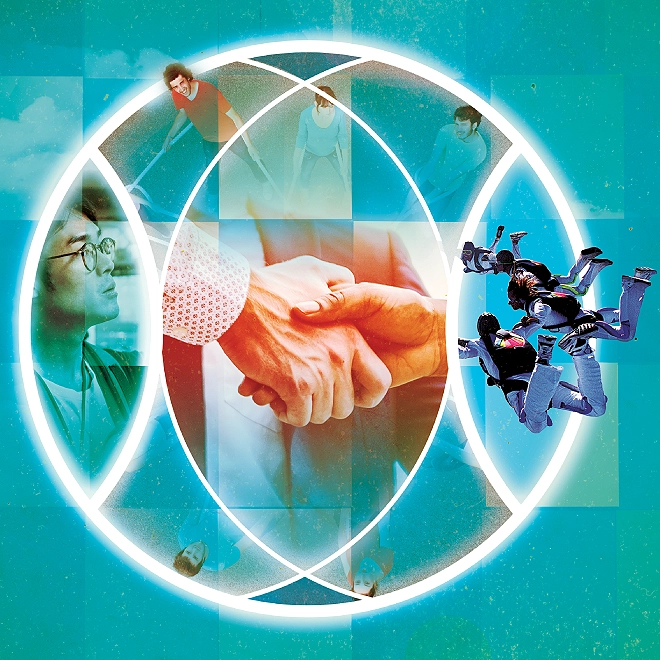Diffusing agility across the organization
How leading brands are building capabilities to market for moments
IDEATE, iterate, pivot, agile—once considered buzzwords heard only at the local startup incubator, these concepts are now ubiquitous across global businesses. To create and maintain an edge in today’s complex, demanding marketplace, companies often need adaptive models that can enable them to keep up with the speed of culture, conversation, and digitization. The dynamic social, economic, and cultural environment also necessitates agile decision-making—particularly in marketing, where increasingly discriminating buyers are adopting, consuming, and disposing of brands more frequently and casually.
Many leading brands are separating themselves from the pack by being more purposeful and hyper-focused than ever on the human experience, necessitating a different way of working for their marketing teams. Other brands should follow suit—moving from reactive to proactive engagement in order to address the wants and whims of customers—or potentially be left out of the race. For this, they should restructure their marketing functions, leverage the power of real-time data accessed through digital platforms, and quickly gain insights to design more personalized, human experiences in an agile manner (see sidebar, “What is agile marketing?” for more).
Agility is both a framework and a mindset. It encourages organizations to embrace immediate and novel ways of thinking while helping them restructure in a way that allows their brand to join conversations and moments organically. Here are two examples showcasing how businesses are becoming more agile:
- TD Bank maximizes operational flexibility: Realizing the importance of tailoring its services for its customers, TD Bank sought new methods to tap into digital platforms to unlock a deeper understanding of the customer experience. After shifting its marketing investments online, TD Bank needed to leverage customer data more effectively to tailor products and deliver personalized messaging to customers in real time. This required the bank to examine its approach to content generation, while its operational structure required greater flexibility to respond and react to the story the data was telling. To achieve this, TD Bank redesigned its marketing function from a traditional one to one based on “marketing pods”—cross-functional teams capable of rapid prototyping and iteration in producing content.1
- JetBlue improves customer service through Twitter: Traditionally considered a no-frills, low-cost airline, JetBlue recognized the opportunity to enhance its brand identity through improved customer service. The company decided to leverage Twitter to support its customers as close to real time as possible on their journeys. Under this program, JetBlue encourages customers to tweet their needs and complaints to its account and ensures they receive immediate replies, explaining what is causing flight delays or other problems. In addition, taking cues from the tweets, JetBlue deploys its airport staff to help passengers on the ground. Through these efforts, the airline repositioned itself as a “customer service company that happens to fly planes.”2 So, what made this possible? JetBlue transformed its customer service operations by removing oversight and hierarchical bottlenecks to empower employees to independently respond to issues as they arise.
What is agile marketing?
Agility draws on the key principles of “agile”3 software development. It is a framework that can enable organizations to move closer to customers by helping them embrace adaptive thinking and structure cross-functional teams to increase their speed, quality, flexibility, and effectiveness in reacting to moments in the market. It also can help companies capitalize on emerging technologies such as artificial intelligence (AI) to predict and generate meaningful engagements with customers in nearly real time.
Agility pushes marketing to move beyond mere content creation by offering an organizational model for businesses to quickly design, create, and launch marketing campaigns. An agile model can allow companies to validate hypotheses and pivot based on customer interactions and timely insights. Further, agility facilitates learning and assessing the impact of marketing on connections with customers to capture return on investment.
TD Bank and JetBlue are just two examples of companies realizing the need for new approaches to better engage with customers. Across the marketing landscape, our analysis illustrates how many global brands are embedding agile across their organizations in diverse ways. In the agility trend, we delve into common organizational approaches that demonstrate agility in action and discuss the transformation that may be required in marketing departments to implement these approaches.
Agile in action: Two ways to act
Being agile typically requires marketers to shift from conventional approaches of generating marketing content to new, tech-enabled, moment-centric ones. Traditional marketing strategies were built around single campaigns, where static advertisements were developed in stages, turned on, and then turned off when the campaign ended. Brands latching on to agile should recognize the need to adapt both the framework and mindset across the organization. They should also build internal capabilities and cross-functional teams that speed up their reaction time to capitalize on societal moments, while leveraging predictive technologies to gain a share of culture and conversation rather than just a share of voice or brand impression. Our trends research surfaced two specific agile strategies organizations are adopting:
- Building the “if/then” campaign. With agile approaches, marketers create batches of marketing content to be rolled out in a 48- to 72-hour window, if trends or live events chart a specific course in real time. For instance, printing world championship T-shirts of both competitors in the major sporting event. Sports apparel companies and franchises have scaled this “if/then” thinking to the marketing department. As sports seasons and end-of-year tourneys unfold, marketing teams prepare for possible outcomes by crafting alternate campaigns to prepare for winners in key championship games. This approach requires companies to produce batches of content in advance based on an “if/then” condition and push it out depending on the outcome of the event or trend.
- Acting in near real time. Brands at the forefront of real-time engagement with customers are doing more than simply increasing the speed of their reaction time. They’re fundamentally shifting their culture and organizational structure—including reconfiguring their marketing departments—to support real-time customer engagement.4 Fernando Machado, global CMO at Burger King, attributes his company’s marketing successes to their “desire to be constantly engaging with our fans and our guests. And we know that we can only accomplish that if we move fast.”5 Moving fast is essential to Burger King’s “Traffic Jam Whopper” program, which debuted in Mexico City in spring 2019. Utilizing real-time traffic data to determine when roads near a Burger King (BK) are congested, the company pushes prompts to digital billboards and displays banner ads within the Waze traffic app. Drivers can order on the BK app through voice commands to avoid texting while driving. The billboards then display updates when food is en route and orders are delivered directly to cars stuck in traffic via motorcycles using Google Maps. Burger King reported a 44 percent increase in BK app downloads and a 63 percent increase in daily delivery orders as a result of this program.6
As these examples demonstrate, the accelerating velocity of technology can create opportunities for brands to continuously evolve their messaging and human experience based on near real-time customer insights.
Making agile work: Diffuse it across the organization
To put agile to work, many marketers are diffusing the time-boxed, iterative approach across their organizations in three ways. First, they’re recognizing the need to be cross-functional and embracing a newsroom approach—breaking operational barriers and silos by bringing people closer together to produce content in the moment. Second, marketing teams are delivering content in a more agile manner by embracing new ways of working. These include daily standups, scrums, and piloting and testing methods that can enable teams to work in shorter sprints and move away from annual and quarterly content calendars. Finally, new emerging technologies, led by AI and analytics, are supporting organizations in predicting culture and the direction in which the conversation is moving.
The following examples show how some marketing departments are making agile work for their brands and how you can too:
- Adopt newsroom-style operations. Many companies realize that embodying agile means improving the cross-functionality and proximity of their teams and, often, restructuring of their marketing function to build newsroom-like operations. Take the example of Taco Bell, which instituted a newsroom model to capitalize on the moment after it realized customers were accessing the brand and were most active on its social media channels between 9 p.m. and 2 a.m. From copywriting and legal to public relations and content designers, Taco Bell brought traditionally siloed groups together, enabling shorter lead times, instantaneous legal approvals, and quicker decision-making. This restructuring helped it gain a share of the conversation with customers in the moment, based on what its sensing and data capabilities were saying. 7
Bosch, a German engineering and technology company, similarly recognized the value of proximity among teams in an agile approach. It abolished its traditional structural hierarchy and created small, matrixed business teams, all reporting to a management board. Each “purpose team,” as they were called, was built around specific product and design goals.8 The restructuring required teams to interact more frequently. Daily standups were instituted to produce content in batches, while the marketing team developed the ability to quickly test and incorporate data to see what was working and what was not. - Pilot then scale. Many marketers are piloting agile within a single business unit to test, learn, and iterate how they can make it work for their organizations. For instance, TD Bank in Canada wanted to embrace agile in its digital marketing function.9 The marketing team started with an assessment of the company’s digital maturity across business units to understand where they fell on the digital adoption curve, before piloting agile within a single business unit to gain insights on how to diffuse it across the company. Pulling together six cross-functional workers—from content, analytics, strategy, planning, and leadership—the team developed a “north star” to guide its agile approach with the goal of increasing the number of insurance quotes. Utilizing daily standups and a scrum model, the team ran two-week design sprints over three months, documenting experiences to present lessons learned to the business leadership; the aim was to understand the secret sauce for scaling agile across the company. Lowering barriers to entry by deploying agile in one unit enabled TD Bank to create a scaling plan and adopt it over time. Through the agile pilot, the bank cut costs by 30 percent in the first month and campaign turnaround time within digital marketing moved from four-month timeframes to two weeks. TD Bank also learned that demonstrating the ROI to leaders and achieving quick wins would help other units adopt agile as the company scaled the approach. 10
- Deploy predictive sensing. Agile marketing typically requires internal teams to listen to the conversation and produce content in short windows by testing, measuring, and predicting consumers’ purchases, discussions, and reactions. Marketers have predictive technologies and AI tools such as Heat AI11 to aid them in this “predictive sensing” process. Analytics and AI tools can provide marketers with “social intelligence,” enabling them to predict and sense where conversations are heading. Content and conversations recycle every six hours on average; thus, speed in sensing is key to staying relevant. These tools also help marketing teams quickly identify whether their content is meeting its desired results in the moment. Conversations can be forecast 72 hours in advance, allowing a brand roughly three days to anticipate, create, and launch content.12
For example, in 2018, Facebook and National Geographic teamed up to grow a new community focused on “Women of Impact.” Leveraging sensing technology and AI to crowdsource and predict trending keywords and topics, the team created content using agile and expanded the community to four times its original size in just two weeks.13 Armed with such insights, flexible teams can abandon an underperforming idea, pivot, and update their creative approach to capitalize on what is being learned. On the back end, insights and patterns in the data also reveal the impact of the investment, offering learnings for the organization on where to go next.
Accelerating for moments that matter
Marketing leaders and departments can lead the agile charge for the entire organization, and in the process, transform their companies into customer-centric operations. By embracing agile across structures, teams and processes, and mindsets, brands are better suited to act and capitalize on moments to create deeper engagement with customers.

Deloitte Digital
Digital technology has changed the face of business. Across the globe, Deloitte Digital helps clients see what’s possible, identify what’s valuable, and deliver on it by combining creative and digital capabilities with advertising agency prowess and the technical experience, deep business strategy, and relationships of the world’s largest consultancy. Deloitte Digital empowers businesses with the insights, platforms, and behaviors needed to continuously and rapidly evolve to perform beyond expectations.
Learn more


